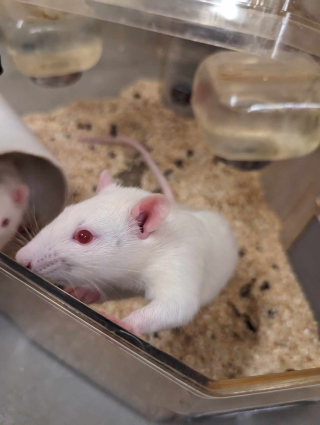- Psychedelics
- Melatonin
- Neuropathic pain
- Cannabis
- Mood disorders
- Treatment-resistant depression
- Other
Psychedelics

You can learn more about the field and our current research in our two reviews (here and here).
Psychedelic Publications
Gobbi G. (2024). CCNP Innovations in Neuropsychopharmacology Award: The psychopharmacology of psychedelics: where the brain meets spirituality. Journal of psychiatry & neuroscience : JPN, 49(5), E301–E318. https://doi.org/10.1503/jpn.240037
Inserra, A., Piot, A., De Gregorio, D., & Gobbi, G. (2023). Lysergic Acid Diethylamide (LSD) for the Treatment of Anxiety Disorders: Preclinical and Clinical Evidence. CNS drugs, 37(9), 733–754. https://doi.org/10.1007/s40263-023-01008-5
Onofrj, M., Russo, M., Delli Pizzi, S., De Gregorio, D., Inserra, A., Gobbi, G., & Sensi, S. L. (2023). The central role of the Thalamus in psychosis, lessons from neurodegenerative diseases and psychedelics. Translational psychiatry, 13(1), 384. https://doi.org/10.1038/s41398-023-02691-0
Inserra, A., Giorgini, G., Lacroix, S., Bertazzo, A., Choo, J., Markopolous, A., Grant, E., Abolghasemi, A., De Gregorio, D., Flamand, N., Rogers, G., Comai, S., Silvestri, C., Gobbi, G., & Di Marzo, V. (2023). Effects of repeated lysergic acid diethylamide (LSD) on the mouse brain endocannabinoidome and gut microbiome. British journal of pharmacology, 180(6), 721–739. https://doi.org/10.1111/bph.15977
De Gregorio, D., Inserra, A., Enns, J. P., Markopoulos, A., Pileggi, M., El Rahimy, Y., Lopez-Canul, M., Comai, S., & Gobbi, G. (2022). Repeated lysergic acid diethylamide (LSD) reverses stress-induced anxiety-like behavior, cortical synaptogenesis deficits and serotonergic neurotransmission decline. Neuropsychopharmacology : official publication of the American College of Neuropsychopharmacology, 47(6), 1188–1198. https://doi.org/10.1038/s41386-022-01301-9
Aguilar-Valles, A., De Gregorio, D., Matta-Camacho, E., Eslamizade, M. J., Khlaifia, A., Skaleka, A., Lopez-Canul, M., Torres-Berrio, A., Bermudez, S., Rurak, G. M., Simard, S., Salmaso, N., Gobbi, G., Lacaille, J. C., & Sonenberg, N. (2021). Antidepressant actions of ketamine engage cell-specific translation via eIF4E. Nature, 590(7845), 315–319. https://doi.org/10.1038/s41586-020-03047-0
De Gregorio, D., Popic, J., Enns, J. P., Inserra, A., Skalecka, A., Markopoulos, A., Posa, L., Lopez-Canul, M., Qianzi, H., Lafferty, C. K., Britt, J. P., Comai, S., Aguilar-Valles, A., Sonenberg, N., & Gobbi, G. (2021). Lysergic acid diethylamide (LSD) promotes social behavior through mTORC1 in the excitatory neurotransmission. Proceedings of the National Academy of Sciences of the United States of America, 118(5), e2020705118. https://doi.org/10.1073/pnas.2020705118
De Gregorio, D., Enns, J. P., Nuñez, N. A., Posa, L., & Gobbi, G. (2018). d-Lysergic acid diethylamide, psilocybin, and other classic hallucinogens: Mechanism of action and potential therapeutic applications in mood disorders. Progress in brain research, 242, 69–96. https://doi.org/10.1016/bs.pbr.2018.07.008
De Gregorio, D., Posa, L., Ochoa-Sanchez, R., McLaughlin, R., Maione, S., Comai, S., & Gobbi, G. (2016). The hallucinogen d-lysergic diethylamide (LSD) decreases dopamine firing activity through 5-HT1A, D2 and TAAR1 receptors. Pharmacological research, 113(Pt A), 81–91. https://doi.org/10.1016/j.phrs.2016.08.022
Melatonin

Melatonin
López-Canul, M., He, Q., Sasson, T., Ettaoussi, M., Gregorio, D., Ochoa-Sanchez, R., Catoire, H., Posa, L., Rouleau, G., Beaulieu, J. M., Comai, S., & Gobbi, G. (2024). Selective Enhancement of REM Sleep in Male Rats through Activation of Melatonin MT1 Receptors Located in the Locus Ceruleus Norepinephrine Neurons. The Journal of neuroscience : the official journal of the Society for Neuroscience, 44(29), e0914232024. https://doi.org/10.1523/JNEUROSCI.0914-23.2024
Posa, L., De Gregorio, D., Lopez-Canul, M., He, Q., Darcq, E., Rullo, L., Pearl-Dowler, L., Luongo, L., Candeletti, S., Romualdi, P., Kieffer, B. L., & Gobbi, G. (2022). Supraspinal melatonin MT2 receptor agonism alleviates pain via a neural circuit that recruits mu opioid receptors. Journal of pineal research, 73(4), e12825. https://doi.org/10.1111/jpi.12825
Posa, L., Lopez-Canul, M., Rullo, L., De Gregorio, D., Dominguez-Lopez, S., Kaba Aboud, M., Caputi, F. F., Candeletti, S., Romualdi, P., & Gobbi, G. (2020). Nociceptive responses in melatonin MT2 receptor knockout mice compared to MT1 and double MT1 /MT2 receptor knockout mice. Journal of pineal research, 69(3), e12671. https://doi.org/10.1111/jpi.12671
Comai, S., Lopez-Canul, M., De Gregorio, D., Posner, A., Ettaoussi, M., Guarnieri, F. C., & Gobbi, G. (2019). Melatonin MT1 receptor as a novel target in neuropsychopharmacology: MT1 ligands, pathophysiological and therapeutic implications, and perspectives. Pharmacological research, 144, 343–356. https://doi.org/10.1016/j.phrs.2019.04.015
Gobbi, G., & Comai, S. (2019). Sleep well. Untangling the role of melatonin MT1 and MT2 receptors in sleep. Journal of pineal research, 66(3), e12544. https://doi.org/10.1111/jpi.12544
Gobbi, G., & Comai, S. (2019). Differential Function of Melatonin MT1 and MT2 Receptors in REM and NREM Sleep. Frontiers in endocrinology, 10, 87. https://doi.org/10.3389/fendo.2019.00087
Posa, L., De Gregorio, D., Gobbi, G., & Comai, S. (2018). Targeting Melatonin MT2 Receptors: A Novel Pharmacological Avenue for Inflammatory and Neuropathic Pain. Current medicinal chemistry, 25(32), 3866–3882. https://doi.org/10.2174/0929867324666170209104926
Comai S, Posa L, Ochoa-Sanchez R, Spadoni G, Gobbi G. (2017). Neuropsychopharmacological properties of novel melatonin MT1 receptor ligands. European Neuropsychopharmacology, 27(4), S569. https://doi.org/10.1016/S0924-977X(17)31098-2
Gobbi G, Lopez-Canul M, Ochoa-Sanchez R, Comai S. (2017). Anxiolytic, hypnotic and analgesic properties of melatonin MT2 receptor partial agonists. European Neuropsychopharmacology. 27(4), S569-S570. https://doi.org/10.1016/S0924-977X(17)31099-4
López-Canul, M., Comai, S., Domínguez-López, S., Granados-Soto, V., & Gobbi, G. (2015). Antinociceptive properties of selective MT(2) melatonin receptor partial agonists. European journal of pharmacology, 764, 424–432. https://doi.org/10.1016/j.ejphar.2015.07.010
Lopez-Canul, M., Palazzo, E., Dominguez-Lopez, S., Luongo, L., Lacoste, B., Comai, S., Angeloni, D., Fraschini, F., Boccella, S., Spadoni, G., Bedini, A., Tarzia, G., Maione, S., Granados-Soto, V., & Gobbi, G. (2015). Selective melatonin MT2 receptor ligands relieve neuropathic pain through modulation of brainstem descending antinociceptive pathways. Pain, 156(2), 305–317. https://doi.org/10.1097/01.j.pain.0000460311.71572.5f
Comai, S., Ochoa-Sanchez, R., Dominguez-Lopez, S., Bambico, F. R., & Gobbi, G. (2015). Melancholic-Like behaviors and circadian neurobiological abnormalities in melatonin MT1 receptor knockout mice. The international journal of neuropsychopharmacology, 18(3), pyu075. https://doi.org/10.1093/ijnp/pyu075
Ochoa-Sanchez, R., Comai, S., Spadoni, G., Bedini, A., Tarzia, G., & Gobbi, G. (2014). Melatonin, selective and non-selective MT1/MT2 receptors agonists: differential effects on the 24-h vigilance states. Neuroscience letters, 561, 156–161. https://doi.org/10.1016/j.neulet.2013.12.069
Comai, S., & Gobbi, G. (2014). Unveiling the role of melatonin MT2 receptors in sleep, anxiety and other neuropsychiatric diseases: a novel target in psychopharmacology. Journal of psychiatry & neuroscience : JPN, 39(1), 6–21. https://doi.org/10.1503/jpn.130009
Comai, S., Ochoa-Sanchez, R., & Gobbi, G. (2013). Sleep-wake characterization of double MT₁/MT₂ receptor knockout mice and comparison with MT₁ and MT₂ receptor knockout mice. Behavioural brain research, 243, 231–238. https://doi.org/10.1016/j.bbr.2013.01.008
Ochoa-Sanchez, R., Rainer, Q., Comai, S., Spadoni, G., Bedini, A., Rivara, S., Fraschini, F., Mor, M., Tarzia, G., & Gobbi, G. (2012). Anxiolytic effects of the melatonin MT(2) receptor partial agonist UCM765: comparison with melatonin and diazepam. Progress in neuro-psychopharmacology & biological psychiatry, 39(2), 318–325. https://doi.org/10.1016/j.pnpbp.2012.07.003
Domínguez-López, S., Mahar, I., Bambico, F. R., Labonté, B., Ochoa-Sánchez, R., Leyton, M., & Gobbi, G. (2012). Short-term effects of melatonin and pinealectomy on serotonergic neuronal activity across the light-dark cycle. Journal of psychopharmacology (Oxford, England), 26(6), 830–844. https://doi.org/10.1177/0269881111408460
Ochoa-Sanchez, R., Comai, S., Lacoste, B., Bambico, F. R., Dominguez-Lopez, S., Spadoni, G., Rivara, S., Bedini, A., Angeloni, D., Fraschini, F., Mor, M., Tarzia, G., Descarries, L., & Gobbi, G. (2011). Promotion of non-rapid eye movement sleep and activation of reticular thalamic neurons by a novel MT2 melatonin receptor ligand. The Journal of neuroscience : the official journal of the Society for Neuroscience, 31(50), 18439–18452. https://doi.org/10.1523/JNEUROSCI.2676-11.2011
Rivara, S., Vacondio, F., Fioni, A., Silva, C., Carmi, C., Mor, M., Lucini, V., Pannacci, M., Caronno, A., Scaglione, F., Gobbi, G., Spadoni, G., Bedini, A., Orlando, P., Lucarini, S., & Tarzia, G. (2009). N-(Anilinoethyl)amides: design and synthesis of metabolically stable, selective melatonin receptor ligands. ChemMedChem, 4(10), 1746–1755. https://doi.org/10.1002/cmdc.200900240
Neuropathic Pain

Cannabis

Does cannabis have an effect on mood? We have demonstrated that cannabis at low doses has antidepressant-like effects in animal models and increases the firing activity of serotonin, a neurotransmitter implicated in mood regulation. At higher doses, cannabis decreases this activity. This process is mediated primarily by the prefrontal cortex. We have also shown that the CB1 antagonist rimonabant decreases serotonin activity (see more in PubMed, see also).
More recently, Dr. Gobbi and colleagues have also replicated these data in humans, showing through a meta-analysis that the consumption of cannabis in adolescence increases the risk of depression and suicidal behavior in young adulthood (see here).
Does the enhancement of the endocannabinoid system induce antidepressant-like effects? The enhancement of anandamide (an endogenous cannabinoid), through the blockage of its degrading enzyme FAAH, induces an antidepressant-like effect. The FAAH inhibitors may thus potentially represent a novel target to treat mood disorders (see more in PubMed).
Cannabis Publications
De Gregorio, D., Dean Conway, J., Canul, M. L., Posa, L., Bambico, F. R., & Gobbi, G. (2020). Effects of chronic exposure to low doses of Δ9- tetrahydrocannabinol in adolescence and adulthood on serotonin/norepinephrine neurotransmission and emotional behaviors. The international journal of neuropsychopharmacology, 23(11), 751–761. Advance online publication. https://doi.org/10.1093/ijnp/pyaa058
Gobbi, G., Atkin, T., Zytynski, T., Wang, S., Askari, S., Boruff, J., Ware, M., Marmorstein, N., Cipriani, A., Dendukuri, N., & Mayo, N. (2019). Association of Cannabis Use in Adolescence and Risk of Depression, Anxiety, and Suicidality in Young Adulthood: A Systematic Review and Meta-analysis. JAMA psychiatry, 76(4), 426–434. https://doi.org/10.1001/jamapsychiatry.2018.4500
De Gregorio, D., McLaughlin, R. J., Posa, L., Ochoa-Sanchez, R., Enns, J., Lopez-Canul, M., Aboud, M., Maione, S., Comai, S., & Gobbi, G. (2019). Cannabidiol modulates serotonergic transmission and reverses both allodynia and anxiety-like behavior in a model of neuropathic pain. Pain, 160(1), 136–150. https://doi.org/10.1097/j.pain.0000000000001386
Bambico, F. R., Hattan, P. R., Garant, J. P., & Gobbi, G. (2012). Effect of delta-9-tetrahydrocannabinol on behavioral despair and on pre- and postsynaptic serotonergic transmission. Progress in neuro-psychopharmacology & biological psychiatry, 38(1), 88–96. https://doi.org/10.1016/j.pnpbp.2012.02.006
Bambico, F. R., Cassano, T., Dominguez-Lopez, S., Katz, N., Walker, C. D., Piomelli, D., & Gobbi, G. (2010). Genetic deletion of fatty acid amide hydrolase alters emotional behavior and serotonergic transmission in the dorsal raphe, prefrontal cortex, and hippocampus. Neuropsychopharmacology : official publication of the American College of Neuropsychopharmacology, 35(10), 2083–2100. https://doi.org/10.1038/npp.2010.80
Bambico, F. R., Nguyen, N. T., Katz, N., & Gobbi, G. (2010). Chronic exposure to cannabinoids during adolescence but not during adulthood impairs emotional behaviour and monoaminergic neurotransmission. Neurobiology of disease, 37(3), 641–655. https://doi.org/10.1016/j.nbd.2009.11.020
Hill, M. N., Hillard, C. J., Bambico, F. R., Patel, S., Gorzalka, B. B., & Gobbi, G. (2009). The therapeutic potential of the endocannabinoid system for the development of a novel class of antidepressants. Trends in pharmacological sciences, 30(9), 484–493. https://doi.org/10.1016/j.tips.2009.06.006
Bambico, F. R., Duranti, A., Tontini, A., Tarzia, G., & Gobbi, G. (2009). Endocannabinoids in the treatment of mood disorders: evidence from animal models. Current pharmaceutical design, 15(14), 1623–1646. https://doi.org/10.2174/138161209788168029
Bambico, F. R., & Gobbi, G. (2008). The cannabinoid CB1 receptor and the endocannabinoid anandamide: possible antidepressant targets. Expert opinion on therapeutic targets, 12(11), 1347–1366. https://doi.org/10.1517/14728222.12.11.1347
Di Marzo, V., Gobbi, G., & Szallasi, A. (2008). Brain TRPV1: a depressing TR(i)P down memory lane?. Trends in pharmacological sciences, 29(12), 594–600. https://doi.org/10.1016/j.tips.2008.09.004
Gobbi, G., Bambico, F. R., Mangieri, R., Bortolato, M., Campolongo, P., Solinas, M., Cassano, T., Morgese, M. G., Debonnel, G., Duranti, A., Tontini, A., Tarzia, G., Mor, M., Trezza, V., Goldberg, S. R., Cuomo, V., & Piomelli, D. (2005). Antidepressant-like activity and modulation of brain monoaminergic transmission by blockade of anandamide hydrolysis. Proceedings of the National Academy of Sciences of the United States of America, 102(51), 18620–18625. https://doi.org/10.1073/pnas.0509591102
Mood disorders

Mood Disorder Publications
Aguilar-Valles, A., Haji, N., De Gregorio, D., Matta-Camacho, E., Eslamizade, M. J., Popic, J., Sharma, V., Cao, R., Rummel, C., Tanti, A., Wiebe, S., Nuñez, N., Comai, S., Nadon, R., Luheshi, G., Mechawar, N., Turecki, G., Lacaille, J. C., Gobbi, G., & Sonenberg, N. (2018). Translational control of depression-like behavior via phosphorylation of eukaryotic translation initiation factor 4E. Nature communications, 9(1), 2459. https://doi.org/10.1038/s41467-018-04883-5
Bambico, F. R., Comai, S., Diwan, M., Hasan, S. M. N., Conway, J. D., Darvish-Ghane, S., Hamani, C., Gobbi, G., & Nobrega, J. N. (2018). High frequency stimulation of the anterior vermis modulates behavioural response to chronic stress: involvement of the prefrontal cortex and dorsal raphe?. Neurobiology of disease, 116, 166–178. https://doi.org/10.1016/j.nbd.2018.03.011
Bambico, F. R., Lacoste, B., Hattan, P. R., & Gobbi, G. (2015). Father absence in the monogamous california mouse impairs social behavior and modifies dopamine and glutamate synapses in the medial prefrontal cortex. Cerebral cortex (New York, N.Y. : 1991), 25(5), 1163–1175. https://doi.org/10.1093/cercor/bht310
Treatment-Resistant Depression
In recent years, at the McGill University Health Center, she has developed a registry for patients with treatment-resistant depression, including unipolar and bipolar depression. This Registry is unique in Canada allowing to follow the clinical therapeutic trajectories of people with severe depression. See in Pubmed. See also.
Clinical Studies
Moderie, C., Nuñez, N., Fielding, A., Comai, S., & Gobbi, G. (2022). Sex Differences in Responses to Antidepressant Augmentations in Treatment-Resistant Depression. The international journal of neuropsychopharmacology, 25(6), 479–488. https://doi.org/10.1093/ijnp/pyac017
Moderie, C., Nuñez, N., Comai, S., Saint-Laurent, M., Fielding, A., Low, N., & Gobbi, G. (2022). Distinct Effects of Antidepressants in Association With Mood Stabilizers and/or Antipsychotics in Unipolar and Bipolar Depression. Journal of clinical psychopharmacology, 42(2), 118–124. https://doi.org/10.1097/JCP.0000000000001500
Comai, S., Bertazzo, A., Vachon, J., Daigle, M., Toupin, J., Côté, G., & Gobbi, G. (2019). Trace elements among a sample of prisoners with mental and personality disorders and aggression: correlation with impulsivity and ADHD indices. Journal of trace elements in medicine and biology : organ of the Society for Minerals and Trace Elements (GMS), 51, 123–129. https://doi.org/10.1016/j.jtemb.2018.10.008
Messaoud, A., Mensi, R., Douki, W., Neffati, F., Najjar, M. F., Gobbi, G., Valtorta, F., Gaha, L., & Comai, S. (2019). Reduced peripheral availability of tryptophan and increased activation of the kynurenine pathway and cortisol correlate with major depression and suicide. The world journal of biological psychiatry : the official journal of the World Federation of Societies of Biological Psychiatry, 20(9), 703–711. https://doi.org/10.1080/15622975.2018.1468031
Nuñez, N. A., Comai, S., Dumitrescu, E., Ghabrash, M. F., Tabaka, J., Saint-Laurent, M., Vida, S., Kolivakis, T., Fielding, A., Low, N., Cervantes, P., Booij, L., & Gobbi, G. (2018). Psychopathological and sociodemographic features in treatment-resistant unipolar depression versus bipolar depression: a comparative study. BMC psychiatry, 18(1), 68. https://doi.org/10.1186/s12888-018-1641-y
Gobbi, G., Ghabrash, M. F., Nuñez, N., Tabaka, J., Di Sante, J., Saint-Laurent, M., Vida, S., Kolivakis, T., Low, N., Cervantes, P., Booij, L., & Comai, S. (2018). Antidepressant combination versus antidepressants plus second-generation antipsychotic augmentation in treatment-resistant unipolar depression. International clinical psychopharmacology, 33(1), 34–43. https://doi.org/10.1097/YIC.0000000000000196
Ismaylova, E., Di Sante, J., Szyf, M., Nemoda, Z., Yu, W. J., Pomares, F. B., Turecki, G., Gobbi, G., Vitaro, F., Tremblay, R. E., & Booij, L. (2017). Serotonin transporter gene promoter methylation in peripheral cells in healthy adults: Neural correlates and tissue specificity. European neuropsychopharmacology : the journal of the European College of Neuropsychopharmacology, 27(10), 1032–1041. https://doi.org/10.1016/j.euroneuro.2017.07.005
Nuñez, N. A., & Gobbi, G. (2017). Lurasidone and Mood Stabilizers in Treatment-Resistant Unipolar Depression: A Case Report Study. Journal of clinical psychopharmacology, 37(2), 263–264. https://doi.org/10.1097/JCP.0000000000000664
Ghabrash, M. F., Comai, S., Tabaka, J., Saint-Laurent, M., Booij, L., & Gobbi, G. (2016). Valproate augmentation in a subgroup of patients with treatment-resistant unipolar depression. The world journal of biological psychiatry : the official journal of the World Federation of Societies of Biological Psychiatry, 17(2), 165–170. https://doi.org/10.3109/15622975.2015.1073856
Blier, P., Gobbi, G., Turcotte, J. E., de Montigny, C., Boucher, N., Hébert, C., & Debonnel, G. (2009). Mirtazapine and paroxetine in major depression: a comparison of monotherapy versus their combination from treatment initiation. European neuropsychopharmacology : the journal of the European College of Neuropsychopharmacology, 19(7), 457–465. https://doi.org/10.1016/j.euroneuro.2009.01.015
Gobbi, G., Gaudreau, P. O., & Leblanc, N. (2006). Efficacy of topiramate, valproate, and their combination on aggression/agitation behavior in patients with psychosis. Journal of clinical psychopharmacology, 26(5), 467–473. https://doi.org/10.1097/01.jcp.0000237945.35022.45
Other
Other fields of research we have examined in the past include the psychopharmacology of aggressive behavior, (and part 2), the role of NK1 antagonists in depression and anxiety, effects of paternal deprivation, the impact of drugs of abuse in adolescents, and impacts of amphetamines on youth.